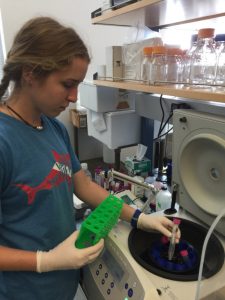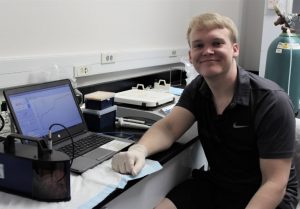Study Finds Gel-like Biofilms May Be More Efficient at Oil Dispersal than Corexit
– APRIL 2, 2019
Scientists conducted mesocosm experiments with natural microbial communities to compare oil emulsion and dispersion mechanisms by microbial secretions of exopolymeric substances, EPS, also known as gels, and Corexit, a dispersant. In the dispersed-oil treatment, microbial secretions had a higher protein-to-polysaccharide ratio and lowered surface water tension more compared to seawater-only and seawater with oil treatments, suggesting effective bio-emulsifying effects of EPS. EPS molecules appeared more efficient in inducing micelle self-assembly of oil with amphiphiles (molecules that have water soluble and water repelling regions) even in very low concentrations, suggesting that EPS can greatly contribute to forming emulsions. Corexit-oil treatments (20 to 1 ratio) maintained a more stable emulsion of colloidal materials containing oil droplets than EPS only molecules; however, they had lower enzymatic action, lower marine-oil-snow sedimentation efficiency, lower phytoplankton diversity and abundance, lower biodegradation extent, and lower oxidative change in molecular composition.
The researchers recently published their findings in Marine Chemistry: Protein: Polysaccharide ratio in exopolymeric substances controlling the surface tension of seawater in the presence or absence of surrogate Macondo oil with and without Corexit.
The sea surface microlayer acts as a gateway for moving substances in and out of the water and is an interface between water-soluble and water-repelling molecules. Thus, amphiphilic molecules that have both water-soluble and water-repelling regions (such as man-made surfactants or EPS) and water-repelling molecules (such as oil) that accumulate at the air-water interface can affect the water’s surface tension. However, little is known about the ability of EPS to reduce surface tension, which enhances oil dispersion.
“Surface tension is when the molecules form stronger bonds with their neighbors at the surface than in the bulk solution where they can share intermolecular forces in all directions. This phenomenon acts as if a surface film is formed and explains how insects, whose density is more than water, can walk on water,” said study author Kathleen Schwehr. “Microbes, such as algae and bacteria, secrete “sea snot” when they are stressed. This sea snot is made up of proteins and complex sugars, which can form either a network of sticky gels or a type of soapy detergent depending on the varying amounts of protein and sugar. The sticky gel type can grow into an aggregate of marine snow. The soapy detergent type can act in a similar fashion to Corexit, the dispersant used to break up the oil slick into microdroplets so that the microbes can eat the oil.”
To address this knowledge gap, the team analyzed over a four-day period Gulf of Mexico seawater treated with Macondo surrogate oil (water accommodated fractions of oil or WAF), seawater treated with Corexit plus oil (chemically-enhanced WAF or CEWAF), and seawater treated with Corexit and diluted ten times (DCEWAF). Estimates of oil equivalents for WAF were in the upper range of oil concentrations reported during and a few months after Deepwater Horizon where only 5% of over 20,000 sample concentrations were above 0.25 mg/L. The experiment set up is as described in Wade et al., 2017, where estimates of oil equivalence in experiments using open ocean water were 3.4 (WAF), 3.6 (DCEWAF), and 36 mg/L (CEWAF).
Using a tensiometer, the team measured a time series of the surface water tension compared to the protein and polysaccharide concentrations. They took images using a fluorescent dye and confocal laser scanning microscopy to show how the molecules were dispersed or assembled at the surface and looked at images from a scanning electron microscopy to show large aggregates in the protein solutions and dispersed small aggregates in the soapy Corexit solution.
“We found that when microbes are exposed to oil or to oil and Corexit, they are stressed more than in control treatments of uncontaminated seawater,” explained Schwehr. “In response, they release EPS that is higher in protein and sugar content, but the gel-like aggregates do not grow as large or become dense enough to sink without added minerals. We found that it takes only a few milligrams (the weight of about 8 female fleas) per liter of protein to lower the surface tension enough to form micellular detergent, but it takes about 2.5 times more Corexit than protein to form micelles. So, this suggests that protein-rich EPS can enhance the natural self-cleansing capabilities of the water column if we can figure out how to trigger this mechanism for producing EPS with a higher protein content.”
Schwehr talked about the insights gained into the extent that exudates are amphiphilic and how that relates to understanding oil fate and distribution in the surface ocean, “When the microbes secrete the EPS molecules, they diffuse to an interface they have an affinity to until they have such a high concentration that they self-assemble into soapy emulsions or sticky glues around mineral particles. Small changes in the EPS composition can make a big difference, and we are studying ways that this might be made more useful to planning oil spill response.”
The study authors are Kathleen A. Schwehr, Chen Xu, Meng-Hsuen Chiu, Saijin Zhang, Luni Sun, Peng Lin, Morgan Beaver, Cameron Jackson, Oscar Agueda, Charles Bergen, Wei-Chun Chin, Antonietta Quigg, and Peter H. Santschi.
Data are publicly available through the Gulf of Mexico Research Initiative Information and Data Cooperative (GRIIDC) at doi:10.7266/N7PK0D64, doi:10.7266/N78P5XZD, doi:10.7266/N74X568X, and doi:10.7266/N79W0D1K.
By Nilde Maggie Dannreuther. Contact maggied@ngi.msstate.edu with questions or comments.
************
This research was made possible in part by grants from the Gulf of Mexico Research Initiative (GoMRI) to the Aggregation and Degradation of Dispersants and Oil by Microbial Exopolymers (ADDOMEx) consortium.
The Gulf of Mexico Research Initiative (GoMRI) is a 10-year independent research program established to study the effect, and the potential associated impact, of hydrocarbon releases on the environment and public health, as well as to develop improved spill mitigation, oil detection, characterization and remediation technologies. An independent and academic 20-member Research Board makes the funding and research direction decisions to ensure the intellectual quality, effectiveness and academic independence of the GoMRI research. All research data, findings and publications will be made publicly available. The program was established through a $500 million financial commitment from BP. For more information, visit https://gulfresearchinitiative.org/.
© Copyright 2010-2019 Gulf of Mexico Research Initiative (GoMRI) – All Rights Reserved. Redistribution is encouraged with acknowledgement to the Gulf of Mexico Research Initiative (GoMRI). Please credit images and/or videos as done in each article. Questions? Contact web-content editor Nilde “Maggie” Dannreuther, Northern Gulf Institute, Mississippi State University (maggied@ngi.msstate.edu).







